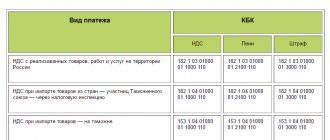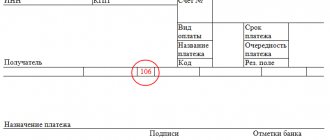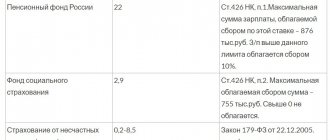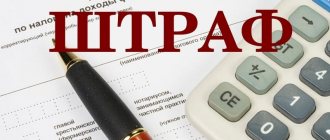A professional accountant must know the new KBK for 2020 in order to do their job efficiently. If you do not take into account the changes, then errors will be made in the documentation and you will not be able to submit reports.
In the new period, the requirements for maintaining official documentation have become a little stricter, so the work may seem more complex and time-consuming, but if you arm yourself with knowledge, the task will be easy to cope with. You just need to familiarize yourself with the KBK taxes for 2020 and remember the basic information.
PFR KBK for 2020
In pension insurance, as in other areas of government activity, new classification codes for budget revenues are used. The main changes to the cbc in 2020 according to the Pension Fund of Russia:
- — 39210202031060000160 – insurance contributions of compulsory pension insurance, which are transferred to the Pension Fund for payment of the insurance part of the pension in the period from 2002 to 2009;
- — 39210202032060000160 – insurance contributions for compulsory pension insurance, which are credited to the Pension Fund for payment of the funded part of the pension, in the period from 2002 to 2009;
- — 39210202100060000160 – insurance contributions for compulsory pension insurance in the amount determined in accordance with the cost of the insurance year, which are credited to the Pension Fund for the payment of labor pension (insurance part) for the billing period that expired before 2013;
- — 39210202110060000160 – insurance contributions for compulsory pension insurance, the amount of which is determined by the cost of the insurance year, credited to the Pension Fund for the payment of labor pension (funded part) for the billing period that expired before 2013;
- — 39210202131060000160 – insurance premiums in the form of an additional tariff for persons employed in certain types of work in accordance with clause 1 of Art. 27 Federal Law “On Labor Pensions of the Russian Federation”, which are credited to the Pension Fund budget for the payment of labor pensions (insurance part);
- — 39210202132060000160 – insurance premiums in the form of an additional tariff for persons engaged in certain types of work, in accordance with clause 2-18 of Art. 27 of the same law, which are credited to the Pension Fund budget for the payment of the labor pension of the insurance part);
- — 39210202140060000160 – insurance contributions for compulsory pension insurance (fixed amount), which are credited to the Pension Fund for the payment of labor pensions (insurance part);
- — 39210202150060000160 – insurance contributions for compulsory pension insurance (fixed amount) which are credited to the Pension Fund for the payment of labor pension (funded part).
KBK personal income tax for 2020
There have also been changes in accounting for personal income taxes. New tax code for 2020:
- — 18210102010011000110 – personal income tax on income the source of which was a tax agent (exception – income under Articles 227, 227.1, 228 of the Tax Code of the Russian Federation);
- — 18210102010012000110 – penalties and interest on personal income tax on income the source of which was the tax agent;
- — 18210102010013000110 – personal income tax fines on income the source of which was a tax agent;
- — 18210102020011000110 – personal income tax on income received in the process of individual entrepreneurial activity, notarial practice, legal practice (in accordance with Article 227 of the Tax Code of the Russian Federation);
- — 18210102020012000110 – penalties and interest with personal income tax on income received from business, notary and lawyer activities;
- — 18210102020013000110 – personal income tax fines on income when carrying out business, notary and lawyer activities;
- — 18210102030011000110 – personal income tax on income received by individuals (according to Article 228 of the Tax Code of the Russian Federation);
- — 18210102030012000110 – penalties and interest on personal income tax on the income of individuals;
- — 18210102030013000110 – personal income tax fines on the income of individuals;
- — 18210102040011000110 – personal income tax in the form of advance fixed payments on the income of individuals of foreign citizens carrying out labor activities under a contract of employment with individuals (according to Article 227.1 of the Tax Code of the Russian Federation);
- — 18210102040012000110 – penalties and interest on personal income tax in the form of advance fixed payments on the income of individuals of foreign citizens carrying out labor activities under a contract of employment with individuals;
- — 18210102040013000110 – personal income tax fines in the form of advance fixed payments on the income of individuals of foreign citizens carrying out labor activities under a contract of employment with individuals.
Income from profits of a controlled foreign company
If the controlling person receives income from a foreign company, the BCC will be required to pay income tax.
Individual
KBC for personal income tax payment for individuals:
| KBK | Payment |
| 18210102010011000110 | If the tax agent pays personal income tax |
| 18210102020011000110 | Tax on profits received by notaries or persons engaged in private practice |
| 18210102050011000110 | Personal income tax on the income of those persons who are recognized as controlling persons of a foreign company |
KBK FSS for 2020
New budget classification code for the social insurance fund:
- — 39310202050071000160 – insurance premiums for OSSNSPZ;
- — 39310202050072000160 – penalty for insurance premiums for OSSNSPZ;
- — 39310202050073000160 – fines from insurance premiums for OSSNSPZ;
- — 39310202090071000160 – insurance premiums for OSSSVNSM;
- — 39310202090072000160 – penalty for insurance premiums for OSSSVNSM;
- — 39310202090073000160 – fines from insurance premiums for OSSSVNSM;
- — 39311620020076000140 – fines for violation of the laws of the Russian Federation on state funds and compulsory social insurance.
What is the KBK and what role does it play?
KBK stands for Budget Classification Code. As mentioned earlier, it is a combination of numbers with the help of which the analysis of the listed taxes and duties to the state treasury is carried out.
The Budget Code of the Russian Federation is mentioned in the Budget Code of the Russian Federation, since it is this law that is intended to regulate budgetary legal relations in the country.
In relation to the issue of payment of land tax, this code serves as a identifier of the department to which the amount of this tax should ultimately be credited. As you know, land tax is one of the local ones, so KBC will help the bank that distributes the received funds to identify the tax payment with its corresponding purpose.
KBK consists of twenty digits, forming several blocks:
- administrative (the first 3 digits are the payment addressee);
- income (from 4 to 13 digits, where it is specified which budget and what payment was made);
- program (4 characters, regarding taxes this is “1000”);
- classifying (3 signs that reflect a specific type of economic activity).
Using it you can determine:
- where did the money come from;
- who is the sender;
- For what purposes should the payment be redirected?
KBK Compulsory Medical Insurance for 2020
New KBK compulsory medical insurance for 2020:
- — 39210202101081011160 – compulsory medical insurance contributions for the working population (for 2013);
- — 39210202101081012160 – compulsory medical insurance contributions for the working population, which were previously credited to the budget of territorial funds;
- — 39210202101082011160 – penalty on contributions to compulsory medical insurance of the working population for debt for 2012;
- — 39210202101082012160 – penalty on contributions to compulsory health insurance of the working population, credited to the budget of territorial funds;
- — 39210202101083011160 – fine for compulsory medical insurance contributions for 2012;
- — 39210202101083012160 — fines on contributions to compulsory medical insurance of the working population credited to the budget of territorial funds (for periods up to 01/01/2012).
KBK codes for 2020
Every accountant should have the new KBK table for 2020.
This will make it easier to remember all the numbers and not get confused by them. In addition, it is important to understand the structure of the codes themselves. The first 3 digits are the administrator code (manager of the corresponding budget). The fourth digit is the group indicator. Incomes occupy the 5th and 6th categories of the KBK. The next 7-11 numbers are articles and subarticles. In digits 12,13 the code of the element of your income assigned to the budget is hidden. Numbers from 14 to 17 are the income program code used for separate tax accounting (the tax, penalty or fine itself differs by code).
Digits 18-20 – transaction classification code. We must not forget that the BCC of expenses for 2013, as well as the BCC of income for 2013, have changed. Therefore, you need to be up to date in order to avoid errors in accounting and documentation.
Sign designations
KBK 2020 consists of 20 characters and is divided into groups consisting of 1-5 characters each:
| Character number/numbers | What do they mean |
| From 1 to 3 | Indicates the addressee to whom the payment is intended. For example, when paying income tax, the first three digits of the BCC are 182, and when paying contributions to the Pension Fund - 392 |
| 4 | Indicates a group of financial receipts |
| From 5 to 6 | Tax code. collection For example, fear. contributions – 02, excise taxes and insurance. contributions – 03, and payment of state duty – 08 |
| From 7 to 11 | Art. and sub-item of receipt |
| From 12 to 13 | They indicate the budget level where the money will go. For example, fed. level – 01, region. – 02 |
| From 14 to 17 | Reason for performing a financial transaction |
| From 18 to 20 | Income category. For example, payment of tax is reflected as 110, and receipts on a gratuitous basis - as 150 |
KBK for 2020 UTII
The BCC for tax on the imputed taxation system has not changed in any way. The main codes remain the same:
- — 18210502010021000110 – UTII for certain types of activities;
- — 18210502010022000110 – penalty and interest on UTII for certain types of activities;
- — 18210502010023000110 – fines on UTII for certain types of activities;
- — 18210502020021000110 – UTII for certain types of activities for the period up to January 1, 2011;
- — 18210502020022000110 – penalty and interest on UTII for certain types of activities for the period up to January 1, 2011;
- — 18210502020023000110 – fines on UTII for certain types of activities for the period up to January 1, 2011.
KBK land tax 2020
Budget classification codes for land tax for 2020 have also undergone changes:
- — 18210606011031000110 – land tax on objects located in intra-city municipalities of federal cities (Moscow, St. Petersburg), levied according to pp. 1 clause 1 art. 394 Tax Code of the Russian Federation;
- — 18210606011013200110 – penalty and interest on land tax on properties located in intra-city municipalities of federal cities (Moscow, St. Petersburg), charged according to pp. 1 clause 1 art. 394 Tax Code of the Russian Federation;
- — 18210606011033000110 – fines for land tax on objects located in intra-city municipalities of cities of federal significance (Moscow, St. Petersburg), collected according to paragraphs. 1 clause 1 art. 394 Tax Code of the Russian Federation;
- — 18210606012041000110 – land tax on objects located within the boundaries of urban districts, according to clause 1 clause 1. Art. 394 Tax Code of the Russian Federation;
- — 18210606012042000110 – penalty and interest on land tax on properties located within the boundaries of urban districts, according to clause 1 clause 1. Art. 394 Tax Code of the Russian Federation;
- — 18210606012043000110 – fines for land tax on objects located within the boundaries of urban districts, according to clause 1 clause 1. Art. 394 Tax Code of the Russian Federation;
- — 18210606013051000110 – land tax on objects located within the boundaries of intersettlement territories, according to clause 1, clause 1 of Art. 394 Tax Code of the Russian Federation;
- — 18210606013052000110 – penalty and interest on land tax on objects located within the boundaries of intersettlement territories, in accordance with clause 1, clause 1 of Art. 394 Tax Code of the Russian Federation;
- — 18210606013053000110 – fines for land tax on objects located within the boundaries of intersettlement territories, in accordance with clause 1, clause 1 of Art. 394 Tax Code of the Russian Federation;
- — 18210606013101000110 – land tax on objects located within the boundaries of settlements, in accordance with paragraph 1, paragraph 2 of Art. 394 Tax Code of the Russian Federation;
- — 18210606013102000110 – penalty and interest on land tax on objects located within the boundaries of settlements, in accordance with paragraph 1, paragraph 2 of Art. 394 Tax Code of the Russian Federation;
- — 18210606013103000110 – fines for land tax on objects located within the boundaries of settlements, in accordance with paragraph 1, paragraph 2 of Art. 394 Tax Code of the Russian Federation;
- — 18210606021031000110 – land tax on objects located within the boundaries of intra-city formations of settlements of federal significance (Moscow, St. Petersburg), according to clause 2 of clause 1 of Art. 394 Tax Code of the Russian Federation;
- — 18210606021032000110 – penalty and interest on land tax on objects located within the boundaries of intra-city formations of settlements of federal significance (Moscow, St. Petersburg), according to clause 2 of clause 1 of Art. 394 Tax Code of the Russian Federation;
- — 1821060602103300110 – fines for land tax on objects located within the boundaries of intra-city formations of settlements of federal significance (Moscow, St. Petersburg), according to paragraph 2 of paragraph 1 of Art. 394 Tax Code of the Russian Federation;
- - 18210606022041000110 - land tax on objects located within the boundaries of urban districts, according to paragraph 2, paragraph 1. Art. 394 Tax Code of the Russian Federation;
- — 18210606022042000110 – penalty and interest on land tax on properties located within the boundaries of urban districts, according to paragraph 2, paragraph 1. Art. 394 Tax Code of the Russian Federation;
- — 18210606022043000110 – land tax fines for objects located within the boundaries of urban districts, according to paragraph 2, paragraph 1. Art. 394 Tax Code of the Russian Federation;
- — 18210606023051000110 — land tax on objects located within the boundaries of intersettlement territories, according to clause 2, clause 1 of Art. 394 Tax Code of the Russian Federation;
- — 18210606023052000110 – penalty and interest on land tax on objects located within the boundaries of intersettlement territories, in accordance with paragraph 2, paragraph 1 of Art. 394 Tax Code of the Russian Federation;
- — 18210606023053000110 – fines for land tax on objects located within the boundaries of intersettlement territories, in accordance with paragraph 2 of paragraph 1 of Art. 394 Tax Code of the Russian Federation;
- — 18210606023101000110 — land tax on objects located within the boundaries of settlements, in accordance with paragraph 2, paragraph 2 of Art. 394 Tax Code of the Russian Federation;
- — 18210606023102000110 – penalty and interest on land tax on objects located within the boundaries of settlements, in accordance with clause 2, clause 2 of Art. 394 Tax Code of the Russian Federation;
- — 18210606023103000110 – fines for land tax on objects located within the boundaries of settlements, in accordance with paragraph 2, paragraph 2 of Art. 394 Tax Code of the Russian Federation.
How to find out the organization code
To find out the BCC, you can use the official website of the Federal Tax Service. To do this, just enter “KBK” in the search bar on the main page and go to the first result in the search.
The service is called “Budget Revenue Classification Codes...”. You must select the payer category - legal entity, individual or individual entrepreneur. Finally, select the tax or fee to be paid.
A table will appear; the 1st column will contain the income item, and a little to the right - the corresponding budget classification code.
KBK 39310202090071000160 for 2020
These are insurance contributions for compulsory social insurance in case of temporary disability, as well as in connection with maternity. Code 39310202090071000160 corresponds to the classification of codes for 2020, as well as classification codes for income to extra-budgetary funds. These are mandatory social insurance contributions. Consists of standard distribution sectors, including name and relationship to a specific budget level.
Without correct and timely accounting of all expenses and income, your income will decrease or simply not grow. “Book of income and expenses in 2013”: https://russtartups.ru/buhgalteriya-2/kniga-dohodov-i-rashodov-2013.html
KBK IFTS for 2020
The Federal Tax Service has identified the main BCCs that must be indicated when paying taxes in 2013:
- — 18210101011011000110 – income tax, which will be credited to the federal budget;
- — 18210101012021000110 — income tax, which will be credited to the budgets of the subjects;
- — 18210301000011000110 – VAT on goods and services sold in the country;
- — 18210401000011000110 — VAT on goods and services imported from other countries;
- — 18210102010011000110 – personal income tax on income from a tax agent;
- — 18210602010021000110 – property tax;
- — 18210604011021000110 – vehicle tax;
- — 18210501011011000110 – tax under the simplified tax system “income”;
- — 18210501021011000110 — tax under the simplified tax system “income reduced by expenses”;
- - 18210502010021000110 - UTII.
Is the tax calculated correctly?
You can find out on your own the amount of tax assessed on land using a standard formula used by the tax authorities themselves. It consists of the cadastral value, which should be multiplied by the size, the selected tax rate and the coefficient used in this case. Although it should be noted that the coefficient should be multiplied only if the duration of ownership of the plot by an individual is less than a year. Otherwise, the coefficient is not used in tax calculations.










